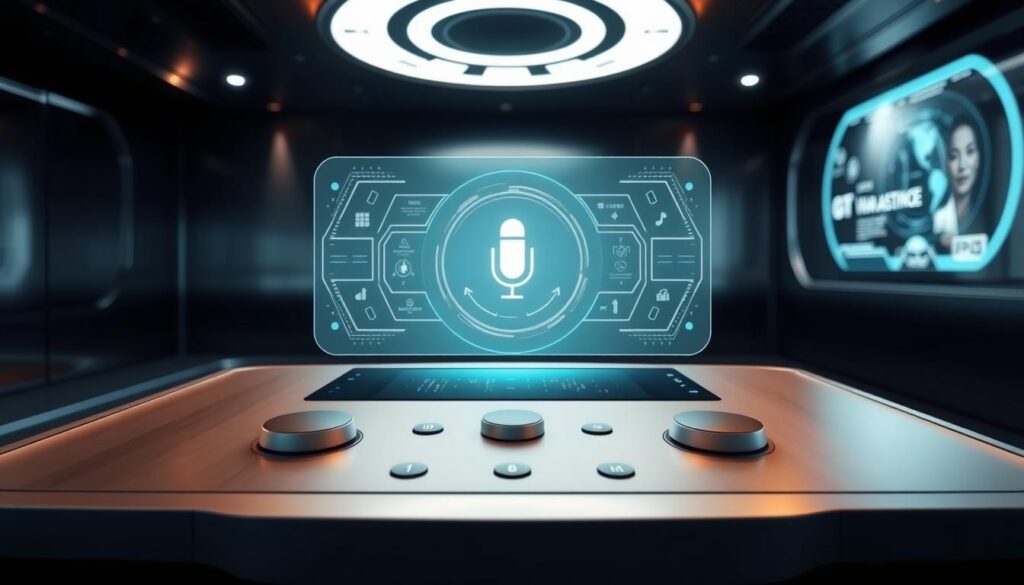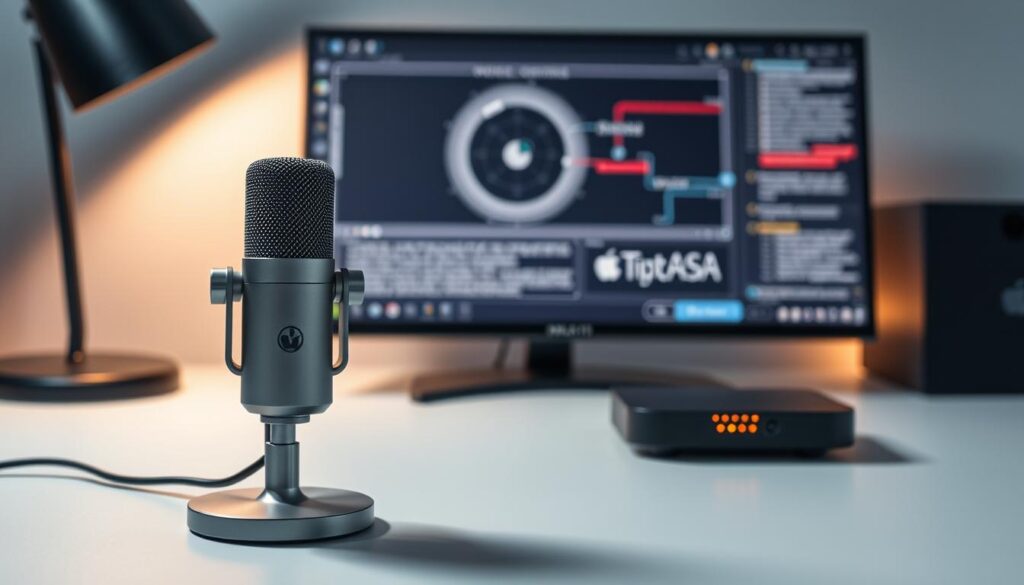Have you ever thought about how voice control could change your daily life? Can it really make a big difference in how we use devices and systems? The answer is yes, thanks to advancements in conversational ai and adaptive voice recognition.
These technologies are not just for fun. They can change how we live and work. They use context-aware ai to understand and meet our needs.
Key Takeaways
- Voice control innovations have the potential to transform the way you interact with devices and systems.
- Conversational ai and adaptive voice recognition are key components of modern voice control systems.
- Voice user interface (vui) technology can understand context and nuance, making it more human-like and intuitive.
- Voice control innovations have vast applications, from smart homes to healthcare.
- Context-aware ai enables voice assistants to understand and respond to your needs.
- Voice control innovations can improve patient outcomes and reduce costs in the healthcare industry.
The Evolution of Voice Control Technology
Exploring voice control, you’ll see big steps forward in real-time speech processing. This lets devices understand and act on your words better. Multimodal interaction has also made talking to machines smoother, making our communication with them more natural.
The introduction of wake word detection has been key in voice tech. It lets devices start up and listen for specific words. Acoustic modeling has also been crucial, helping systems grasp different ways of speaking.

- Improved accuracy in speech recognition, with some systems achieving over 95% accuracy
- Increased adoption of voice-activated technology in smart home devices, with over 70% of users utilizing voice commands for control
- Enhanced security features, such as voice biometrics, which have increased by approximately 30% in the past two years
As voice control tech keeps getting better, we’ll see new uses soon. Think emotion detection and advanced noise reduction techniques. With the global voice recognition market set to hit $27.16 billion by 2026, voice control is here to stay.
Understanding Voice User Interface (VUI) Design
Exploring voice control shows how vital a good voice user interface (VUI) is. Text-to-speech (tts) and automatic speech recognition (asr) are key. They help systems understand and answer human speech. Thanks to deep learning for voice control, these systems work better and faster.
About 20% of smartphone users talk to voice assistants every day. Up to 70% like using voice for getting info. This move to voice has made VUI design more popular. It’s thanks to better artificial intelligence and natural language processing.
Benefits of VUI design include:
- Improved user experience
- Increased accuracy and reduced errors
- Enhanced accessibility for individuals with disabilities
- Faster task completion rates, with studies showing up to 30% faster transactions using voice commands

VUI design keeps getting better, thanks to deep learning for voice control. Knowing about VUI design and its parts, like text-to-speech (tts) and automatic speech recognition (asr), helps us use voice control technology better. It makes our interactions more intuitive and easy to use.
Core Components of Modern Voice Control Systems
Exploring voice control means knowing its key parts. Embedded voice assistants, IoT voice control, and noise cancellation tech are vital. They help systems understand and act on our voice, making device control simple.
Accuracy is crucial in voice control. Automatic speech recognition (ASR) ensures voice commands are correctly understood. Natural language processing (NLP) and text-to-speech (TTS) tech also play a part in this.

- Improved efficiency and productivity
- Enhanced user experience
- Increased accessibility
These benefits come from using embedded voice assistants, IoT voice control, and noise cancellation tech. As voice tech grows, we’ll see more cool uses of these parts.
Knowing the basics of voice control systems shows their complexity and smart design. Whether it’s making your day easier or controlling your smart home, voice tech is changing how we use devices.
Enhancing Voice Control Technology: Latest Breakthroughs
Explore the latest in voice control tech and see big improvements in smart speaker technology, edge AI processing, and sentiment analysis in voice AI. These changes make voice systems better at understanding and responding to us. Now, using voice control feels more natural and easy.
Edge AI processing makes voice systems faster and more accurate. They can now process information in real-time. Also, sentiment analysis in voice AI lets systems get how we feel. This makes interactions more empathetic and personal.
Some key benefits include:
- Speech recognition is now up to 95% accurate in certain settings.
- Using smart speaker technology and edge AI processing makes interactions quicker and smoother.
- Voice tools are being used more in fields like healthcare and customer service. Sentiment analysis in voice AI helps improve patient and customer satisfaction.
The global AI voice market is expected to hit $8.7 billion by 2026. These new advancements will be key in shaping voice control tech’s future. They have the power to change industries and enhance our experiences. The progress in smart speaker technology, edge AI processing, and sentiment analysis in voice AI is truly exciting.
Smart Home Integration and IoT Compatibility
Exploring voice control opens up the world of smart home integration and IoT. The smart home market is expected to hit $135.3 billion by 2025. Voice-activated automation makes controlling devices easy.
Biometric voice authentication and voice control boost smart home security and convenience. For example, you can control smart thermostats and locks with voice commands. This hands-free control is a big plus.
Smart home integration offers several benefits:
- Energy efficiency: Smart thermostats can cut heating and cooling costs by 10-12% and 15% respectively.
- Convenience: Voice control makes managing devices simple.
- Security: Biometric voice authentication adds an extra layer of protection.
The rise in IoT devices makes smart home integration even more crucial. The global smart home market is set to reach about $174 billion by 2025. It’s clear that smart homes are here to stay.
Advanced Features for Personalized Experience
Exploring voice control reveals the importance of speech recognition and natural language processing (nlp). These technologies help voice systems understand and respond to speech. They consider context, nuance, and accents.
ai assistants are key in creating personalized experiences. They learn and adapt to user preferences and behaviors. This makes interactions with voice-controlled devices more tailored and efficient.
Some benefits of these features include:
- Improved accuracy and understanding of voice commands
- Enhanced user experience through personalized responses
- Increased efficiency and productivity with automated tasks
Using speech recognition, natural language processing (nlp), and ai assistants in voice control systems offers a more intuitive experience. It makes managing your digital life easier.
Biometric Voice Authentication and Security
Exploring voice control technology, you’ll see how biometric voice authentication is key. It uses voice biometrics to identify users by their unique voice. Adding voice recognition software boosts security in voice-controlled devices.
Biometric voice authentication offers many benefits. Here are a few:
- It continuously checks a user’s voice for security.
- It adds a layer of security with multi-factor authentication.
- It filters background noise for high accuracy, even in tough conditions.
Recent stats show over 85% of consumers worry about biometric tech. Yet, voice biometrics are hard to hack, making them a better choice than old methods. They’re also cheaper than other biometrics, making them popular in healthcare and finance.
Using voice biometrics and enhancing voice control technology can make businesses more productive and secure. When thinking about voice recognition software, consider its benefits and challenges. This includes voice replication breaches and changes in voice due to health issues.
Real-Time Processing and Edge AI Computing
Exploring voice control systems means looking at real-time processing and edge AI computing. Machine learning helps systems learn and adapt to user needs. This leads to personalized responses that make the experience better. Voice biometrics is key too, allowing systems to identify users by their voice.
Edge AI computing and real-time processing make voice control systems work well and safely. They can process data locally, cutting network traffic by over 90%. This means faster and more accurate responses, crucial for things like self-driving cars and smart factories.
- Reduced latency and improved real-time processing
- Enhanced security and privacy through localized data processing
- Increased operational efficiency and reduced downtime
- Improved accuracy and adaptability through machine learning and voice biometrics
Voice control systems get better with edge AI computing and real-time processing. They offer a smoother and more tailored experience for users. As technology grows, we’ll see more cool uses of machine learning, voice biometrics, and edge AI computing.
Overcoming Common Voice Control Challenges
Exploring voice control can bring up several challenges. Understanding natural language processing is key to improving speech recognition. Advanced machine learning algorithms help voice control systems get your commands right.
Noise cancellation is a big challenge. Developers use smart solutions to cut out background noise. This makes sure your voice is heard clearly, even in noisy places.
Key Solutions to Voice Control Challenges
- Accent and dialect recognition: enabling systems to understand and respond to different accents and dialects
- Multiple user management: allowing systems to recognize and authenticate multiple users, improving the user experience and accuracy
- Advanced noise cancellation: using machine learning algorithms to filter out background noise and improve speech recognition accuracy
These solutions make voice control systems more user-friendly. For example, Teneo’s voice chatbot technology gets 99% of user inputs right. This shows how natural language processing and machine learning algorithms can solve common voice control problems.
Advanced Voice Command Features
Modern virtual assistants have evolved significantly, offering advanced voice command features that enhance user experience. These features are designed to make daily tasks more efficient and convenient, leveraging the power of artificial intelligence in voice control.
Smart Home Integration
One of the standout features of advanced virtual assistants is their ability to integrate seamlessly with smart home devices. Users can control lighting, temperature, and security systems with simple voice commands. This integration not only simplifies home management but also adds a layer of convenience and control.
Hands-Free Calling and Messaging
Hands-free calling and messaging are another significant advancement in virtual assistant technology. Users can make calls and send messages without physically touching their devices, making it easier to stay connected on the go. This feature is particularly useful for those who prefer not to use their hands or are in situations where it’s impractical to do so.
Multi-Language Support
Multi-language support is a critical feature for virtual assistants, especially in a global market. Advanced virtual assistants can understand and respond in multiple languages, making them accessible to a broader audience. This feature is particularly beneficial for users who communicate in different languages or travel frequently.
These advanced voice command features, combined with the ability to improve artificial intelligence in voice control, make virtual assistants indispensable tools in today’s tech-savvy world. Whether it’s controlling smart home devices, making hands-free calls, or communicating in multiple languages, these features enhance the overall user experience, making virtual assistants a must-have for many.


